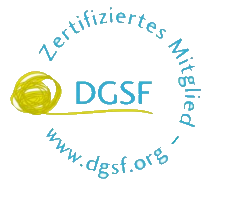
systemic therapy, psychotherapy (according to the law HeilprG for naturopaths / alternative practitioners) and trauma counseling
Eva-Maria Gebert-Riess



Certified member of the umbrella organization DGSF www.dgsf.org

|
Practice for systemic therapy, psychotherapy (according to the law HeilprG for naturopaths / alternative practitioners) and trauma counseling Eva-Maria Gebert-Riess |
   Certified member of the umbrella organization DGSF www.dgsf.org |
|
Would you like to receive event info?
Simply click here to be added to the mailing list. Your mail program will open. You can unsubscribe anytime.
|
Trauma counselling according to the KReST modelTraumas are sudden or long-lasting or even repetitive, objectively or subjectively existentially threatening and hopeless events in which people feel trapped in the defenselessness of the so-called "traumatic forceps" of physical excitement, helplessness, powerlessness and the feeling of being at the mercy of others.Every experience is registered and stored by the brain from the sum of the sensory inputs (images, sounds, language, smells, taste, temperature, touch, etc.) and the channels of perception (thoughts, evaluations, feelings, who is present at the experience, etc.). In addition, every experience, together with the inputs described above, needs a structure with beginning, course, end and meaning in order to be safely registered by the brain, stored as a holistic experience and memory, and be recalled again in the future. These perception, registration and storage mechanisms are interrupted at some points during the experience of a trauma, the traumatic experience is stored in fragments. Symptoms and consequences of trauma can be: anxiety, panic attacks, restlessness, feelings of being driven, concentration problems, performance failure, "flashbacks" (flashes of traumatic images or sensory impressions), depression, sadness, hopelessness, feelings of emptiness, irritation, anger, rage,self-doubt, self-hatred, self-harming behavior, withdrawal to the point of isolation, numerous physical complaints, "self-anaesthetization" in the form of addictive substance abuse, eating disorders, excessive "wanting to feel oneself" (search for danger, extreme sports, etc.), and outbreaks of violence against others. Trauma counselling according to the KReST model is a body-, resource- and system-oriented trauma counselling. After anamnesis and relationship building with the therapist the client learns to perceive, understand and classify their trauma symptoms better. Moreover, the client practices self-control and self-care with regard to their symptoms. In the second phase, the client is stabilized by mobilizing helpful resources, stress management, strengthening the "self" (self-image, self-esteem, self-efficacy), as well as social and physical stabilization. Only when the client feels sufficiently stable, the confrontation with the experienced trauma is carried out with special trauma methods, in order to integrate it as a part of the past into the client's own biography. However, this step can be taken, but must not, in order to stimulate the integration and healing process. This is followed by the fourth phase of the KReST model, the farewell of the not-lived and the reorientation. |
|
Eva-Maria Gebert-Riess - Systemische Therapeutin für Einzelpersonen, Paare und Familien Roseggerstr. 57 - 85521 Ottobrunn Telefon: 0162 612 09 96 - info (at) praxis-gebert-riess.de -  E-Mail E-Mail
|
|
 |